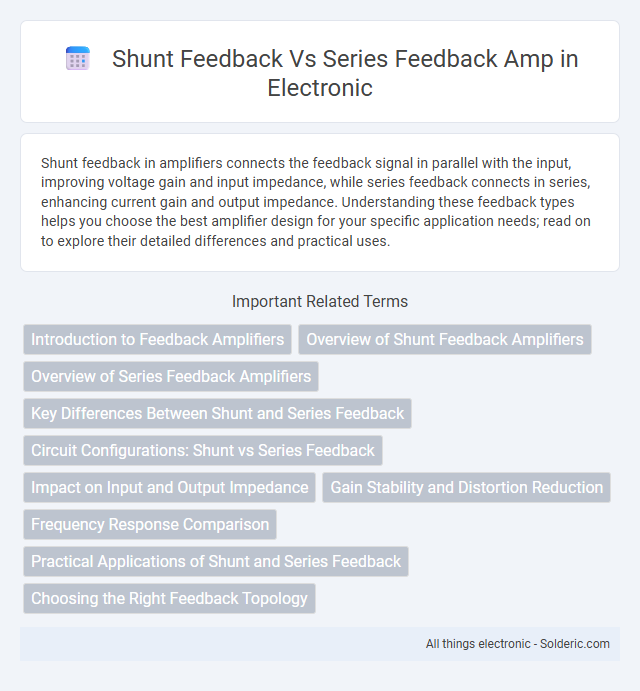Shunt feedback in amplifiers connects the feedback signal in parallel with the input, improving voltage gain and input impedance, while series feedback connects in series, enhancing current gain and output impedance. Understanding these feedback types helps you choose the best amplifier design for your specific application needs; read on to explore their detailed differences and practical uses.
Comparison Table
| Feature | Shunt Feedback Amplifier | Series Feedback Amplifier |
|---|---|---|
| Feedback Connection | Output voltage fed back in parallel (shunt) to input | Output voltage fed back in series with input |
| Input Impedance | Decreases input impedance | Increases input impedance |
| Output Impedance | Decreases output impedance | Increases output impedance |
| Feedback Type | Voltage sampling, voltage mixing | Voltage sampling, current mixing |
| Common Application | Voltage amplifier with low input impedance | Voltage amplifier with high input impedance |
| Effect on Gain Stability | Improves gain stability | Improves gain stability |
| Noise Reduction | Reduces noise and distortion effectively | Reduces noise and distortion effectively |
Introduction to Feedback Amplifiers
Feedback amplifiers enhance signal stability and linearity by routing a portion of the output back to the input. Shunt feedback amplifiers apply feedback parallel to the input, reducing input impedance and increasing bandwidth, whereas series feedback amplifiers feed back in series, increasing input impedance and improving voltage gain accuracy. Your choice between shunt and series feedback depends on the desired input impedance and frequency response requirements.
Overview of Shunt Feedback Amplifiers
Shunt feedback amplifiers apply feedback by connecting the output voltage back to the input in parallel, influencing the input current to stabilize gain and improve linearity. This method enhances bandwidth and reduces distortion by controlling the input impedance, making it ideal for applications requiring precise current regulation. Compared to series feedback amplifiers, shunt feedback offers better input noise performance and improved stability in high-frequency circuits.
Overview of Series Feedback Amplifiers
Series feedback amplifiers feature feedback connected in series with the input signal, improving input impedance and linearity while reducing distortion. This type of feedback stabilizes gain and enhances bandwidth by providing negative feedback through the input node, making the amplifier more predictable under varying conditions. Your choice of series feedback amplifier can optimize signal amplification with tighter control over gain and noise performance.
Key Differences Between Shunt and Series Feedback
Shunt feedback applies feedback by connecting the output voltage back to the input in parallel, reducing input impedance and often used in voltage amplifiers. Series feedback, on the other hand, feeds the output current back in series with the input signal, increasing input impedance and typically employed in current amplifiers. The main differences lie in their effect on input impedance and the nature of the feedback signal--voltage versus current--leading to distinct performance characteristics in amplifier design.
Circuit Configurations: Shunt vs Series Feedback
Shunt feedback amplifiers use parallel connections at the input and output to sample and apply feedback voltage, reducing input impedance and stabilizing gain. Series feedback amplifiers introduce feedback in series with the input, increasing input impedance while controlling current gain and improving linearity. The choice between shunt and series feedback significantly impacts amplifier performance parameters such as input/output impedance, gain stability, and bandwidth.
Impact on Input and Output Impedance
Shunt feedback amplifiers decrease input impedance by placing the feedback signal in parallel at the input, making them ideal for voltage-sensing applications, while series feedback amplifiers increase input impedance by inserting the feedback in series with the input source. Output impedance is reduced in series feedback amplifiers due to the feedback loop controlling the output voltage, improving load driving capability, whereas shunt feedback tends to increase output impedance by sampling output current or voltage in parallel. These impedance characteristics influence amplifier design choices for optimizing signal integrity and matching in various electronic circuits.
Gain Stability and Distortion Reduction
Shunt feedback amplifiers excel in gain stability by providing low input impedance, which minimizes gain variations due to source impedance changes. Series feedback amplifiers offer superior distortion reduction by maintaining high input impedance, allowing more precise linearity in the amplification process. Your choice depends on whether prioritizing consistent gain or minimizing harmonic distortion is most critical for your application.
Frequency Response Comparison
Shunt feedback amplifiers typically exhibit better high-frequency stability due to lower input impedance, which reduces the effect of parasitic capacitances and extends the bandwidth. Series feedback amplifiers often provide improved linearity and gain accuracy but may suffer from reduced frequency response because of increased input impedance and associated pole shifts. Your choice between the two should consider the trade-off between gain precision and frequency response based on the specific application requirements.
Practical Applications of Shunt and Series Feedback
Shunt feedback amplifiers are commonly used in applications requiring low output impedance and high input impedance, such as voltage amplifiers in audio and sensor circuits. Series feedback amplifiers excel in current amplifier designs where precise control of input current and improved linearity are critical, often applied in transistor biasing and sensor interfacing. Your choice between shunt and series feedback depends on the desired impedance characteristics and signal control requirements in the specific practical application.
Choosing the Right Feedback Topology
Choosing the right feedback topology depends on the desired input and output impedance characteristics: shunt feedback lowers input impedance and increases output impedance, making it suitable for voltage amplifiers requiring low input impedance. Series feedback raises input impedance and lowers output impedance, ideal for current amplifiers demanding high input impedance. Understanding these impedance transformations helps optimize amplifier performance for specific signal conditions and stability requirements.
shunt feedback vs series feedback amp Infographic

 solderic.com
solderic.com